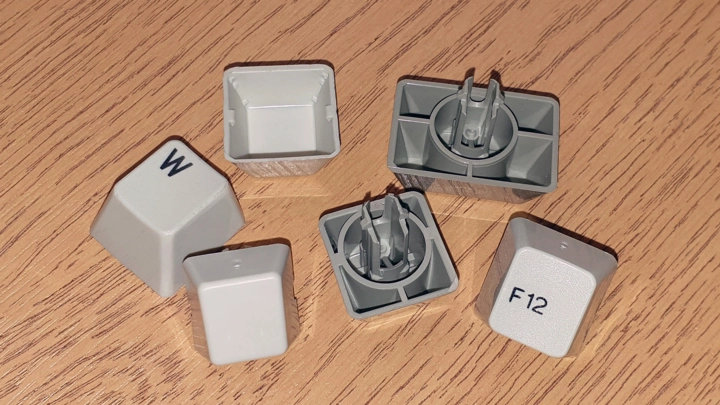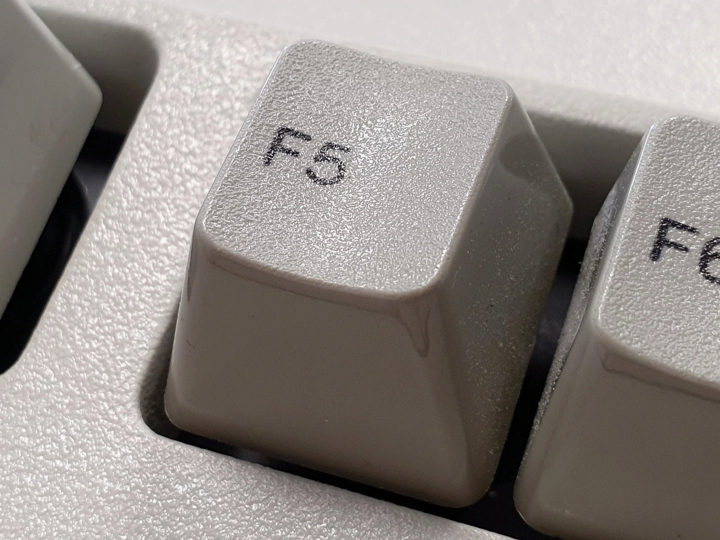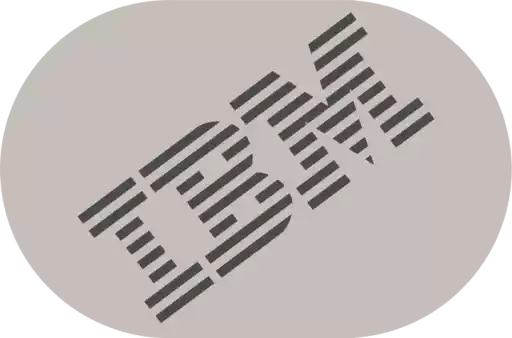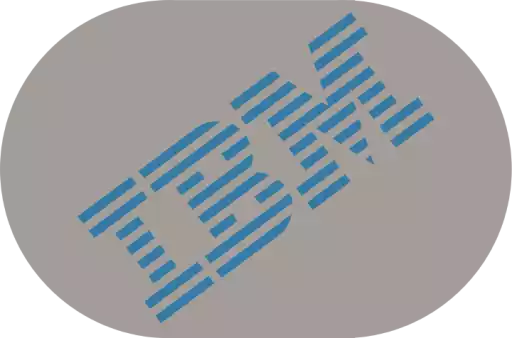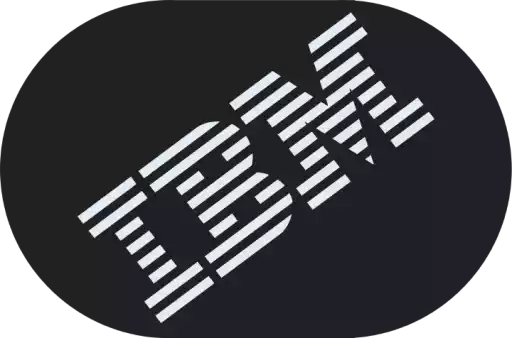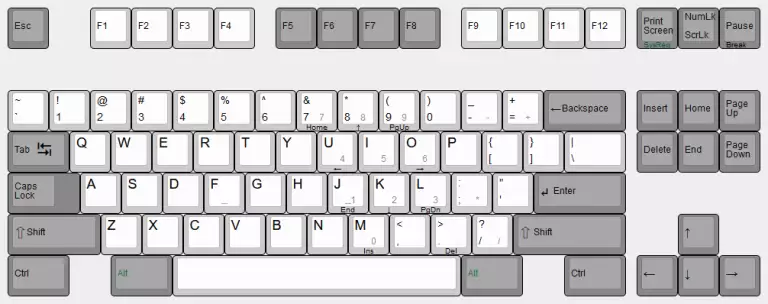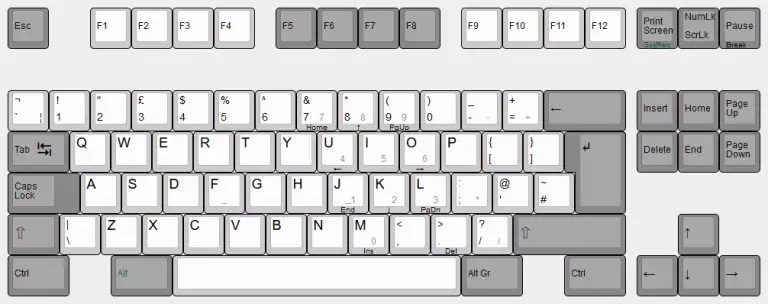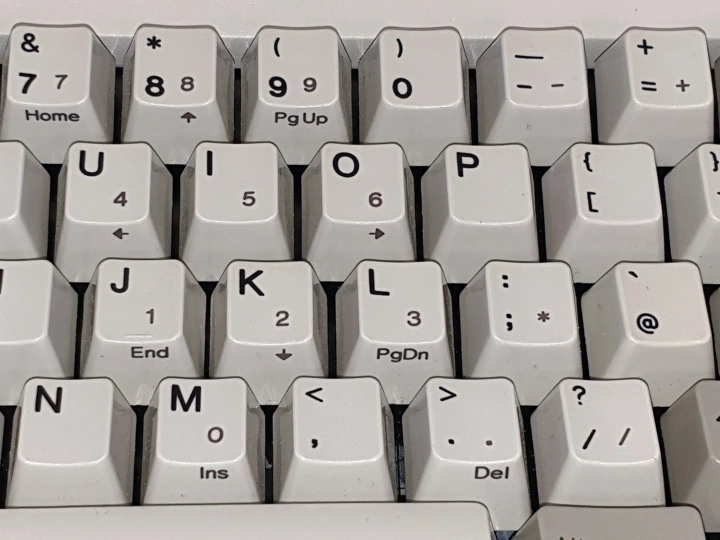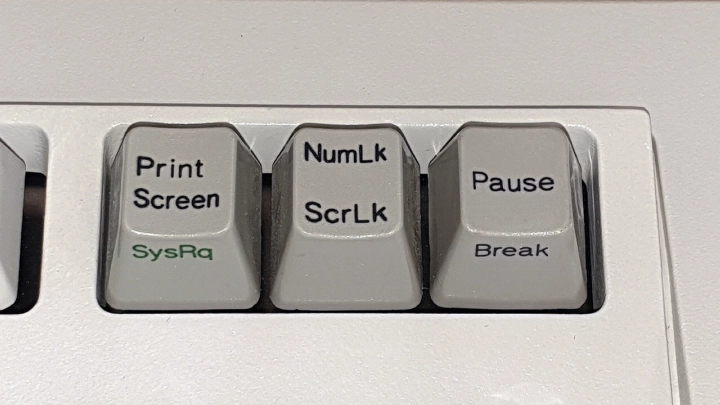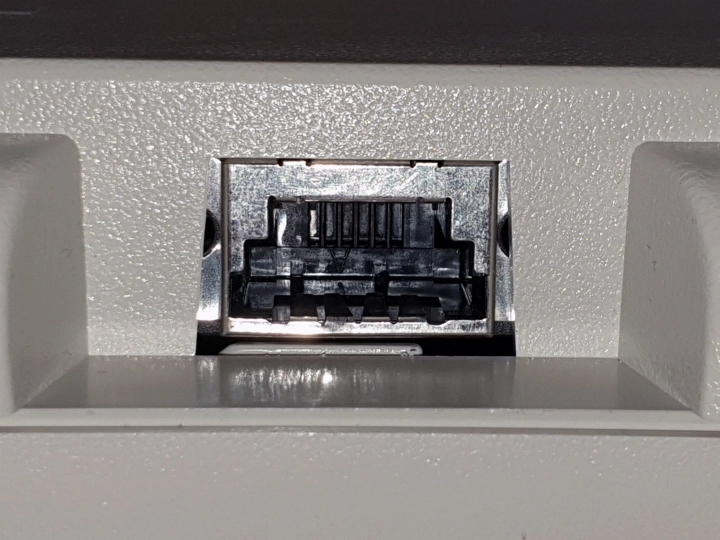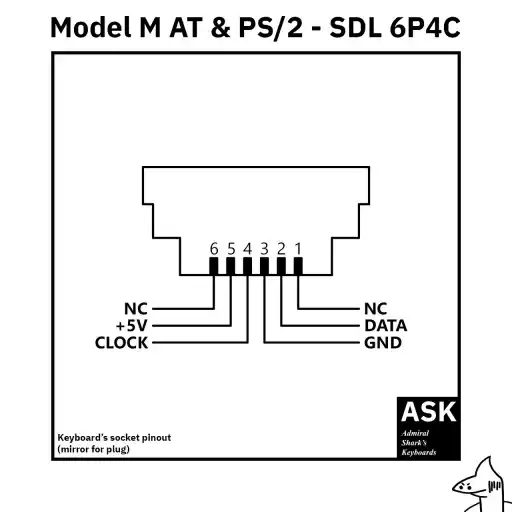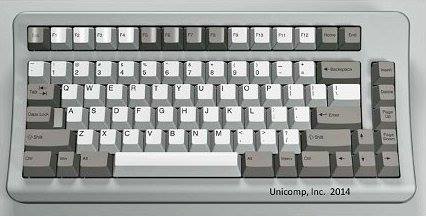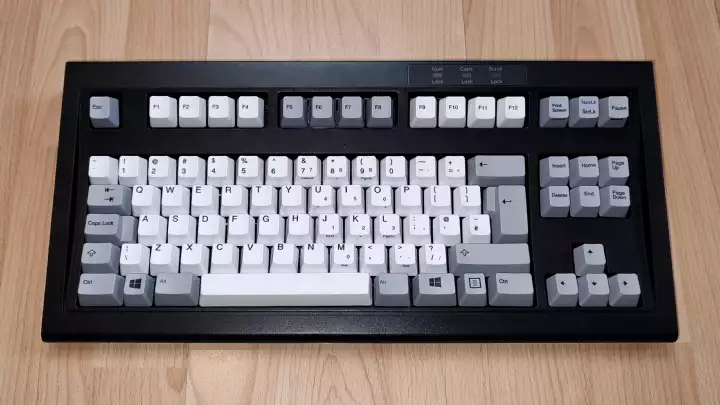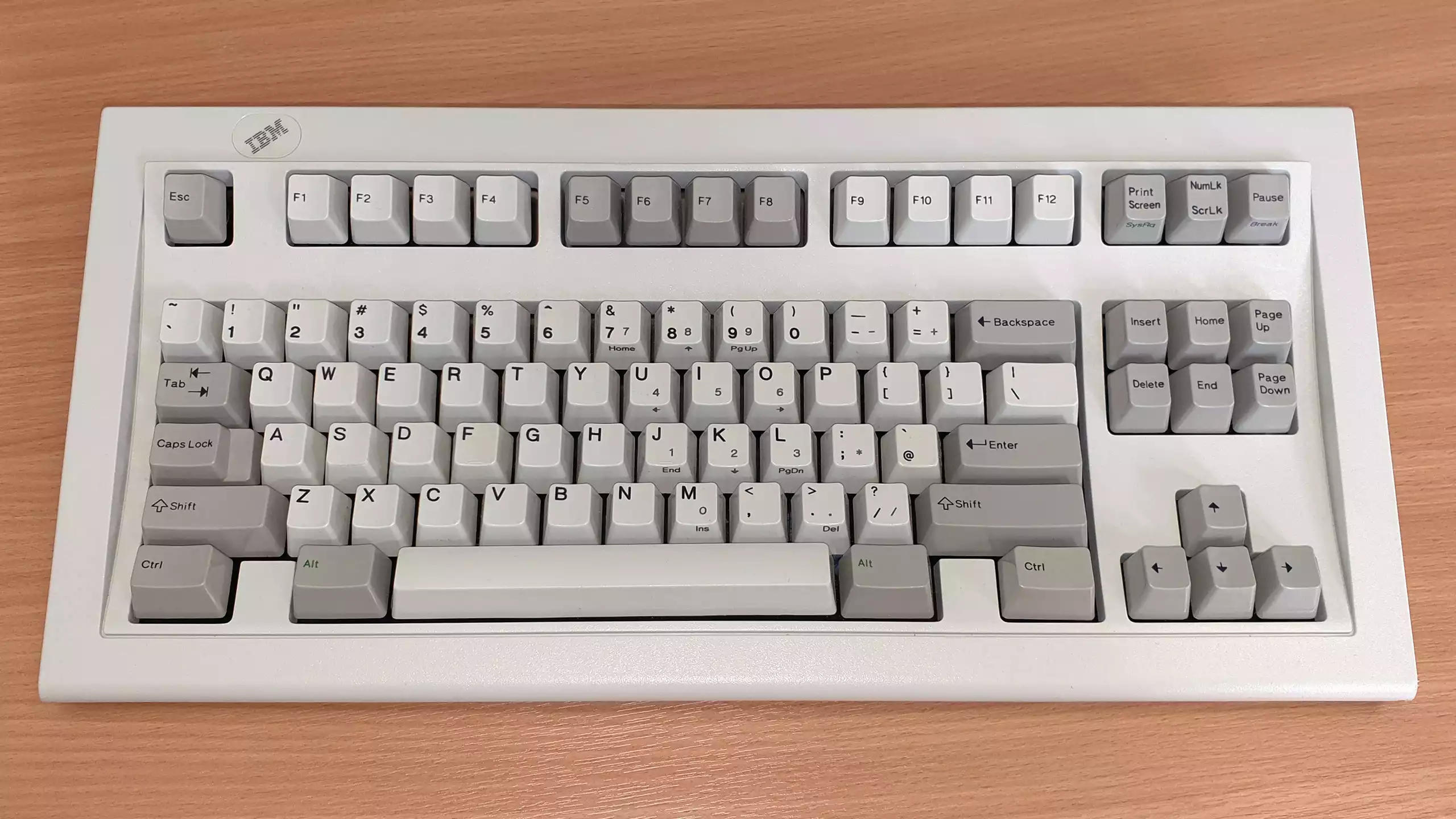Also applies to Lexmark Spacesaver Keyboard and Unicomp 85 Key Space Saver
- Updated
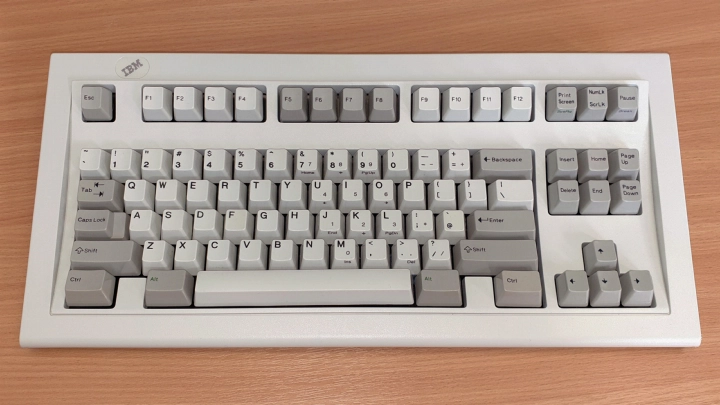
The IBM Space Saving Keyboard was the small form-factor counterpart to IBM's flagship Enhanced Keyboard marketed between 1986 and 1999. Commonly referred to as the "SSK", the Space Saving Keyboard is probably the most famous tenkeyless keyboard of all time and most modern tenkeyless keyboards can trace their heritage to it. Like its larger brethren, the SSK is known for sporting clicky buckling spring key-switches and high-quality dye-sublimated PBT keycaps.
The SSK is a member of the large Model M family of keyboards and is likely its most well-known non-101/102 key variant. Whilst not a flagship keyboard, it's still well regarded and closely tied with the IBM Personal System/2 family of computers. That said, it also found itself with a high number of variations beyond the typical PC-style design and layout for terminals, airline reservation systems, financial systems and even automotive maintenance systems. Over 30 SSK part numbers have been documented.
Contents
| Marketing name(s) | IBM Space Saving Keyboard Lexmark Spacesaver Keyboard Unicomp 85 Key Space Saver |
| OEM(s) | IBM Lexmark |
| Designation | M |
| Family | Model M |
| Switches | IBM buckling spring (membrane variant) |
| Keycaps | Dye-sublimated PBT |
| Overall dimensions | 40.6cm x 19cm x 5.8cm (15.98" x 7.48" x 2.28") |
| Cover set material | PVC |
| Cover set colour(s) | Pearl white Industrial grey |
| Cover set screws | 7/32" (~5.5mm) hexagonal |
| Weight | 1.9kg[1] (~4.2 lbs) |
| Layout | 84 (ANSI) or 85 (ISO) key tenkeyless |
| Connectivity | Modular SDL: 6-pin Mini-DIN Fixed cable: modular 8P5C plug |
| Successor | IBM Model M4 Space Saver Keyboard (indirect) Unicomp Mini Model M (spiritual) |
History
The SSK was amongst the earliest Model M variants introduced, preceded by just Model M-based typewriters, the Enhanced Keyboard and the Types I and II 122-key terminal keyboards. The first SSK announced was the 84-key space-saving "shorter keyboard" for the IBM 3162 ASCII Display Station in September 1986. Its part number was 1391518 and its planned availability was October 1986 for 3162 models 310 and 320 and Q1 1987 for 3162 models 410 and 420[2]. Very few records of this early SSK exist, but it's believed it had a 240-degree pin-arranged DIN plug and would be the only production SSK made to first-generation Model M specifications. The first SSK of which photos are available is the IBM 3151 ASCII Display Station Space Saving Keyboard (P/N 1392980), launched in June 1987 and was available for 3151 models 110 and 160[3].
Despite the existence of these terminal models, SSKs are almost entirely associated with the IBM Personal System/2 series of PCs. Some specific PS/2 models had SSKs bundled with them or at least had an SSK option made available, giving the SSK its largest and most famous utilisation. Starting with the PS/2 Model 25 models 001 and 004 in August 1987[1] then at least followed by the Model 40 SX in June 1991[4], Model 35 SX in October 1991[5], Model 57 SLC in August 1992[6] and Model 95 XP 486 in September 1992[7]. A version of the PS/2 SSK (P/N 1392464) was also used for the PS/2 Model 30-based IBM Personal Typing System series that was first introduced in July 1987[8], just before standard PS/2 SSKs were introduced. Despite all of this, the SSK never saw the same level of adoption the Enhanced Keyboard enjoyed. It's believed that the importance of a dedicated numeric keypad during this period kept the full-size keyboard a more desirable option than the tenkeyless keyboard.
In 1990, IBM introduced the SSK for industrial computers starting with the IBM 7785 Service Bay System, a 386-powered cart-mounted computer based on the IBM Personal System/2 Model 80 for the automotive industry. It originally shipped with keyboard P/N 1395691[9]. In September 1992, IBMs 7537, 7546, and 7568 GEARBOX 800 also received industrial SSK keyboards as options[10]. The most famous industrial SSKs are P/Ns 1395682 and 41G3200 made for Mopar and Ford respectively. In June 1991, the SSK was made available as an option through IBM's Select-A-Keyboard (sometimes written as "Selecta Keyboard") scheme that allowed customers to choose from a variety of keyboards for their system at the time of purchase for no additional charge. At the time, options included the Enhanced Keyboard, the Space Saving Keyboard, and the Host Connected Keyboard (a Type IV 122-key Model M for terminal emulation)[11]. During the 1990s, IBM of course spun off its US-based keyboard manufacturing operations via the divesture of IBM Information Products Corporation forming Lexmark International, and with it saw IBM employ the SSK for increasingly more non-PS/2 or non-PS/2-based systems. According to PC Magazine in February 1992, the SSK was being used for IBM Personal System/1 lower-end computers[12]. When the IBM PC 300 and 700 series were announced in October 1994, the SSK was made available as an option with box P/N 1396050 (containing a P/N 1392934 keyboard)[13][14]. After this though, the SSK along with Model Ms in general would be sidelined as IBM and the industry moved towards lower-cost keyboards.
Whilst many people believe the SSK died with IBM, that's in fact not exactly true. By 2002, successors to Lexmark's keyboard manufacturing operations, Unicomp, began selling P/N UNI04C6 as either the IBM or Unicomp 85 Key Space Saver. This very late SSK is also unique in that it has an ISO-based US English layout. Otherwise, it's a standard PS/2 SSK. Observed birth certificates of these keyboards can say it's a "Modification of IBM P/N 1394054", implying they're assembled from former IBM keyboards and parts rather than actual production. Unicomp stopped selling these when stock dried up sometime in the latter half of the 2000s. Since then, keyboard enthusiasts have continuously demanded a revival of the tenkeyless Model M from Unicomp. In the early 2010s, Unicomp confirmed they were working on such a replacement, which finally launched in 2021 in the form of the Unicomp Mini Model M.
| Date | Model | Original price | 2022 price |
|---|---|---|---|
| 1986-09-02 | IBM 3162 terminal, P/N 1391518 | $180 USD[2] | ~$481 USD |
| 1987-06-16 | IBM 3151 terminal, P/N 1392980 | $104 USD[3] | ~$268 USD |
| 1992-02-25 | IBM PS/1 | $156 USD[12] | ~$325 USD |
| 2002-10-14 | Unicomp PS/2, P/N UNI04C6 | $59 USD[15] | ~$96 USD |
Key-switches
More information: IBM buckling spring#IBMMem
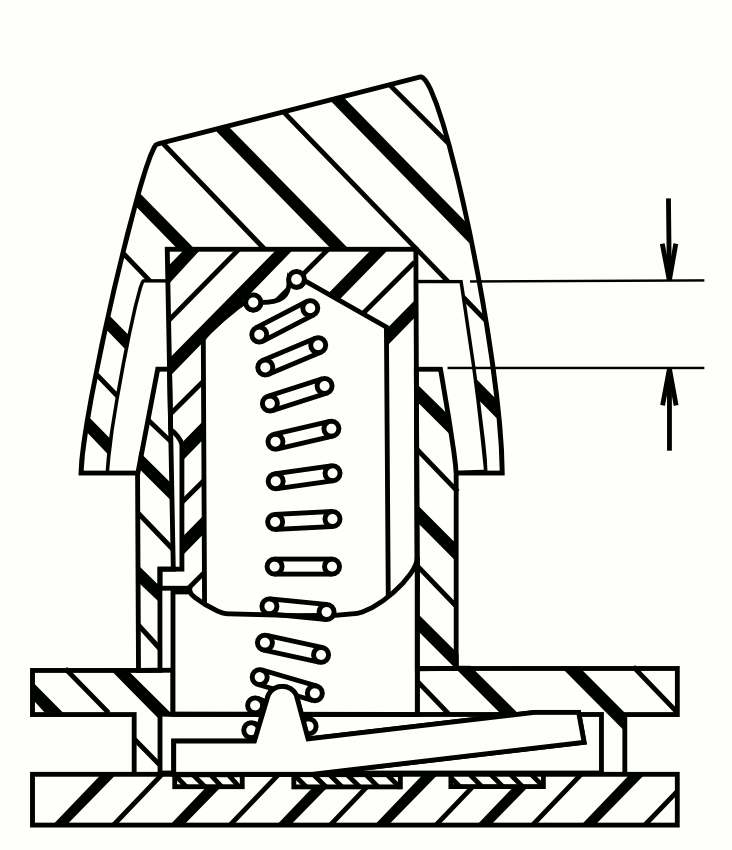
Just like most Enhanced Keyboards, the SSK employs IBM buckling spring over membrane clicky key-switches. Such a switch is comprised of a coil spring, a rocker (also known as a flipper or hammer) and the membrane circuitry underneath - pressing down on a buckling spring key causes the coil spring to compress and eventually buckle, which then rocks the flipper attached to the bottom of the spring thus actuating the membranes[17]. The mechanism rocks the membranes before its fully buckled (bottomed out), allowing for part-way actuation. Key travel is 3.8mm[18]. Unlike the Enhanced Keyboard, the SSK appears to have not received a Quiet Touch rubber dome counterpart.
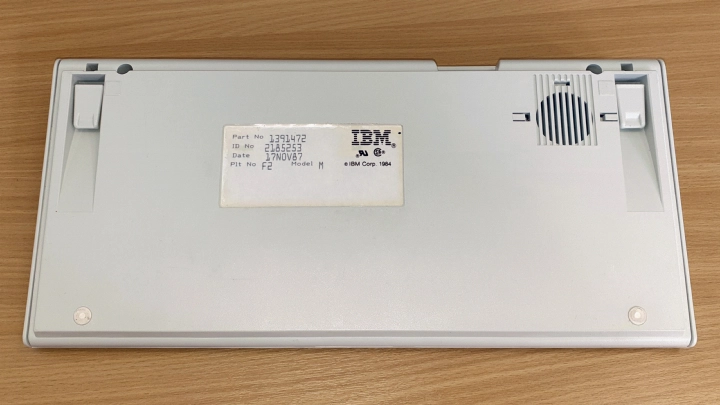
The SSK is designed to heavily resemble the Enhanced Keyboard, so it uses the same colour palette on a similarly wedged-shaped cover set (albeit smaller). This shape facilitates a curved internal assembly that partially swoops up above the F-keys, granting a ledge commonly used to hold items such as pens or pencils. Besides the lack of a dedicated numeric keypad and LED lock-lights, the main dimensional difference between the SSK and the Enhanced Keyboard is a shrinking of the aforementioned space above the F-keys. Thanks to that, the SSK is the first of several Model M keyboards that used the same smaller side profile, that today also comprises the IBM PS/2 50-key Function Keyboard, IBM Screen Reader Keypad, Unicomp New Model M and Unicomp Mini Model M.
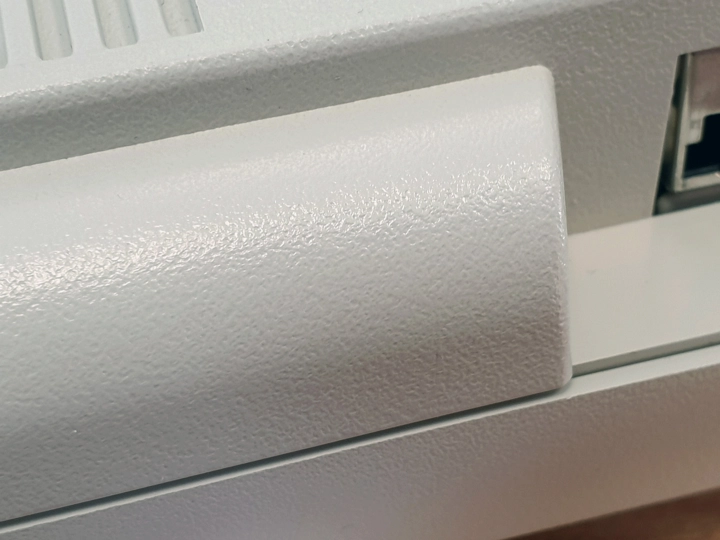
SSK cover sets were believed to be universally made with PVC, which means they typically don't yellow with UV exposure.
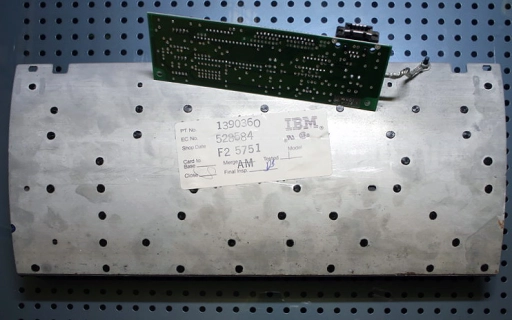
Inside the keyboard is a curved subassembly that is comprised of four layers; the keyboard frame and actuators, the membrane blanket, the membrane assembly, and the base plate.
- The keyboard frame (aka, "barrel plate") sits top facing and is used to guide the individual switch components (the buckling spring actuators) to their correct position above the membrane assembly's contact points. The frame design has a degree of redundancy in the number of barrels available, allowing for a 'one size fit all' design for ANSI and ISO layout keyboards and terminal versions of both. On third-generation and later SSKs, the frame could be modified with channels to allow for liquid drainage.
- The membrane blanket is a rubber sheet used to dampen the stress the actuators exert on the membrane assembly. A Unicomp employee posting on /r/ModelM Discord has stated that a Model M without the blanket is unlikely to reach the rated 25 million key-presses lifetime[20].
- The membrane assembly is a part of the key-switch system used as the circuitry to be actuated and facilitates a 16x8 matrix.
- The base plate (aka, "back plate") provides rigidity and the curvature for all the other layers to follow.
The assembly is held together by many plastic rivets designed to provide the tension needed for the buckling springs to operate properly. Unfortunately, these rivets are the single largest flaw in the Model M design as they can weaken and break with age. Such an issue can be permanently solved with a bolt or screw mod.
SSK keycaps were of IBM's famed PBT dye-sublimated variety. Versus the most common keycap material, ABS[21], PBT is more durable, does not degrade/yellow with age, UV or heat exposure, and will keep its texture for longer without shining[22]. Dye-sublimation is also a very durable text printing method that sinks dye material into the keycap's plastic itself, meaning there is nothing to quickly wear off as would be the case with pad-printing or silk screening. This means many vintage Model M keycaps will still be in good condition, requiring at most a good cleaning. Like Enhanced Keyboards, SSK keycaps could come in a two-piece variety that allows the user to swap the keytops featuring the text legends to alter the layout instead of having to pull the entire keycap out of the barrel. However, a non-insignificant amount of SSKs have been found with one-piece keycaps though.
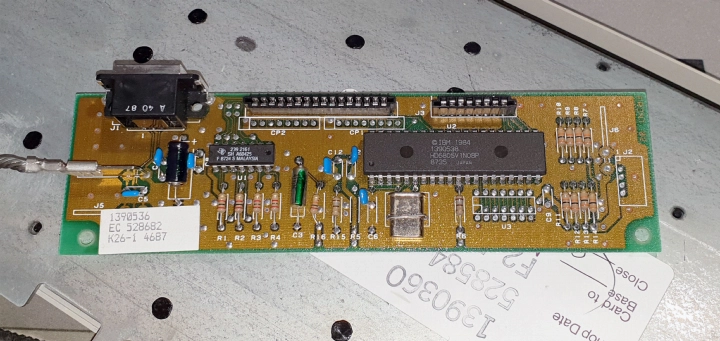
Unlike Enhanced Keyboards, SSK controller PCB designs remained relatively similar throughout their production. IBM and later Lexmark stuck with 16+8 flex cable supporting controllers that early Enhanced Keyboards used, using TE Connectivity's 2.54mm pitched Triomate sockets for the membranes. SSKs also kept using modular shielded data link (SDL) based cables after it fell out of favour with Enhanced Keyboard production.
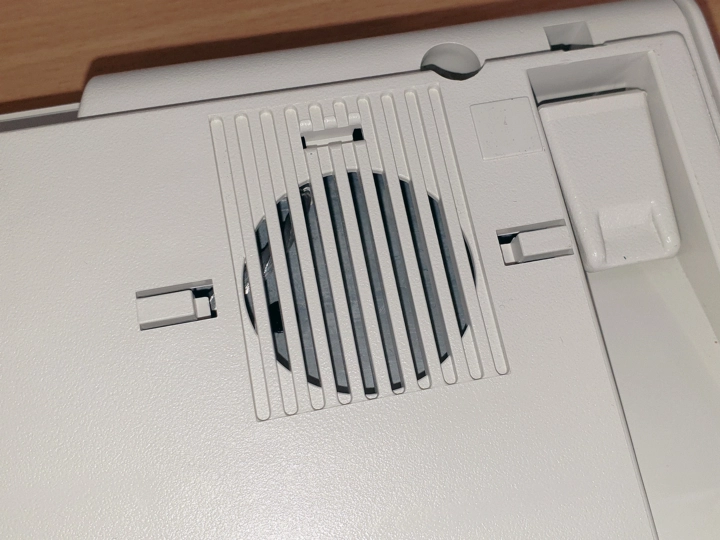
SSKs possess the same speaker grille most Enhanced Keyboards have, however, SSKs with a speaker fitted have yet to be observed. On Enhanced Keyboards, the speaker was only fitted on keyboards destined to be used with RT PC and RS/6000 family computers and was used for providing a system audible queue. The lack of RT PC or RS/6000 SSKs found thus far explains why no SSK has been observed with one.
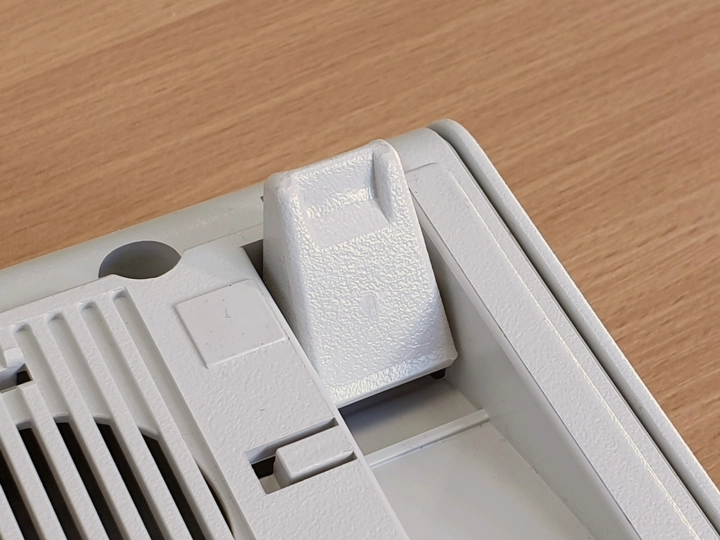
SSKs have only been known with a single style of flip-out feet. It differs from the typical Enhanced Keyboard foot, instead, resembling a shortened Type III 122-key Model M foot.
Branding
Whilst SSKs based on first-generation Model M specs from 1986 (ie, from before Enhanced Keyboards received oval-shaped badges) theoretically exist, they have yet to be observed in modern times. Thus only oval-shaped IBM-branded SSKs are known albeit the oval itself is physically smaller than the ones Enhanced Keyboards sported. This smaller oval is shared with the also Model M-based IBM PS/2 50-key Function Keyboard and IBM Screen Reader Keypad as well. In line with their larger brethren, SSKs originally used an oval with grey text (1987-1992) and then an oval with blue text (1992-). A black oval was introduced in 1990 for the industrial version of the SSK.
Self-branded Lexmark SSKs featured a rectangle logo in the top-left corner. Whilst Unicomp marketed SSKs as late as 2007, the stock they sold either had IBM branding or no branding at all.
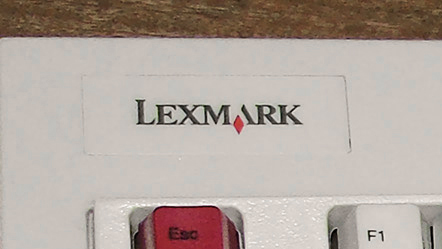
The SSK layout is a subset of the Enhanced layout, being basically the same except lacking a dedicated numeric keypad. The Enhanced layout is essentially the standard keyboard layout that most keyboards today still conform to with the addition of GUI keys and invariably altered modifier unit sizes.
Since numeric keypads were generally viewed favourably in the 1980s, IBM implemented a layer-based numeric keypad that overlays some of the alphanumeric keys. The numeric keypad can be activated by turning on the num lock, and then the navigation commands on it can be used by shift-pressing the relevant keys. Since its usual dedicated placement is gone, the Num Lock key is doubled up with the Scroll Lock key instead and is activated by shift-pressing the key. One consideration with this system is that due to the lack of lock-lights, a rogue num lock may cause frustration when entering passwords, especially if a preview option isn't available. Key legends relating to the overlay numeric keypad were for the most part coloured grey, with some later Unicomp-sold keyboards sporting blue legends instead.
For the most part, the connectivity of SSKs aligns with that of the Enhanced Keyboard. PC-compatible and industrial computer SSKs typically use a 6-pin modular AMP shielded data link (SDL) port and a high-quality detachable coiled cable. This allowed the keyboard to be uncoupled from its cable as needed. Whilst SSKs were generally not intended for use with IBM PC/AT systems, SDL to 5-pin DIN cables from PC/AT Enhanced Keyboards could be used with SDL-based SSKs if desired.
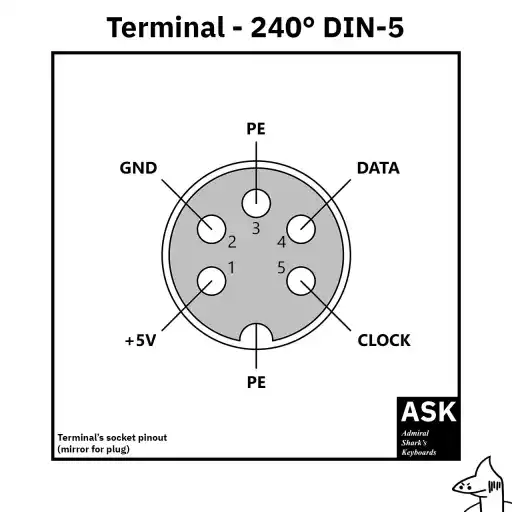
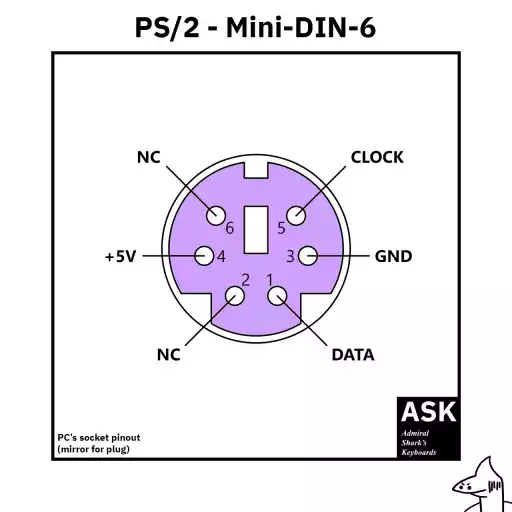
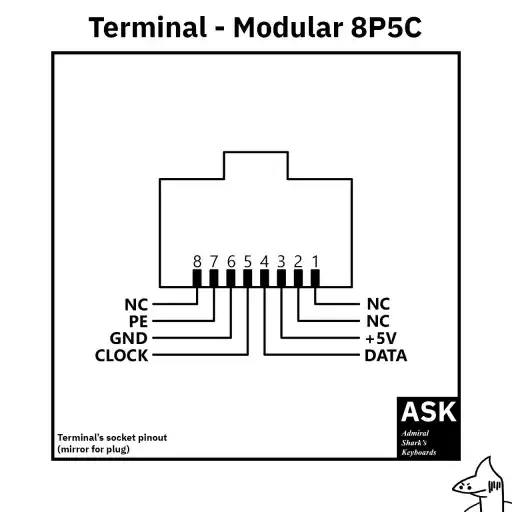
Terminal variants have fixed cables with either 5-pin DIN connectors with a 240-degree PIN arrangement (IBM 3162 SSK) or modular 8P5C "RJ-45" jacks (IBM 3151 SSK). Terminal SSKs also generate IBM set 3 scancodes, contrasting the set 2 (aka, "AT") scancodes PC and industrial SSKs used.
DIN terminal Space Saving Keyboard (1986)
The first SSK was the so-called "shorter keyboard" option for the IBM 3162 ASCII Display Station, P/N 1391518. The keyboard was made available in October 1986, making it likely the only SSK made to first-generation specifications however no photos of this keyboard have been found. Despite the lack of photos, it can be assumed it connected via a 240-degree pin arranged DIN plug and spoke IBM scancode set 3 since Enhanced Keyboards for the 3162 (as well as the 3162 terminal itself) have been observed and they indeed have that plug.
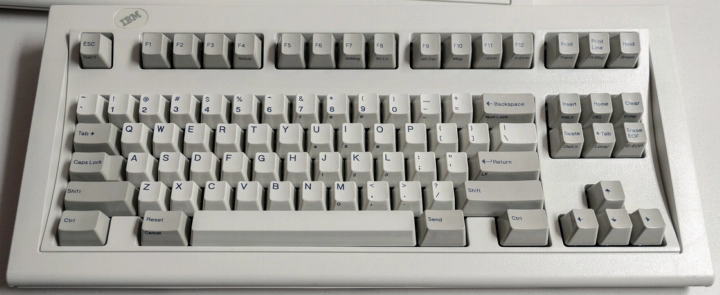
The modular 8P5C connecting terminal SSKs are the earliest that can be properly described. Once again, only a sole part number (1392980) is known and it was intended for the IBM 3151 ASCII Display Station models 110 and 160. The keyboard was made available alongside the 3151 in June 1987, two months sooner than the first IBM Personal System/2 computer that came with an SSK. What's unusual about the 3151 SSK is that despite it being a terminal keyboard, it retains a modular cable via an SDL jack unlike any terminal version of the Enhanced Keyboard. P/N 1392980s seem to support scancode set 2 as well since examples sold with SDL to PS/2 cables have been observed[24].
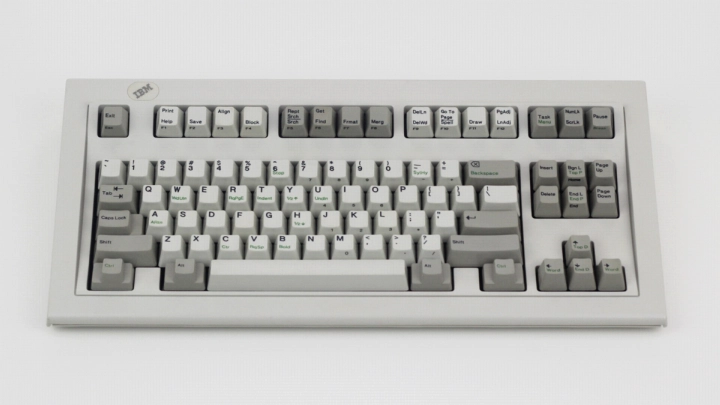
The IBM Personal Typing System (PTS) family were a series of IBM Personal System/2 Model 30 variants intended for word processing that came with specialised software, a networking expansion card, and possibly a Wheelwriter or Quietwriter printer. The series included the IBM 6901 Personal Typing System (introduced in July 1987), 6907 Personal Typing System/2 and 6908 Personal Typing System/2 286 (both introduced in July 1989)[26]. They notably shipped with the IBM Personal Typing System Program, which was a bundle of a word processing application similar to IBM's past Displaywriter systems, a combined typewriting and form creation and editing application, and various productivity tools such as a personal scheduler, a calculator and a mail/phone list creator and editor[27]. Personal Typing Systems could come with either this Space Saving Keyboard variant or an Enhanced Keyboard variant. The PTS SSK was based on and electrically identical to the PS/2 SSK but sported numerous unique legends on its keycaps to suit its word-processing speciality. Many of these keys resemble those found on IBM Wheelwriter and Quietwriter electronic typewriters, especially given that the alphabetic and numeric row key legends are particularly aligned to the keycap top face's top-left corner just like legends on either typewriter. Uniquely for an SSK, it had stepped modifier keys which also had green sublegends on the Ctrl keys instead of the Alt keys. The keyboard was made across the second and third generations, branded with an IBM oval and used a modular SDL to PS/2 cable. The PTS' word processing application was said to have been derived from the IBM DisplayWrite Assistant program, which resulted in this keyboard (along with its Enhanced Keyboard sibling) acquiring the nickname "DisplayWrite Keyboard" despite the included software not being branded as "DisplayWrite".

eg, P/Ns 1370475, 1391472, 1392934, 1393278
Just like the Enhanced Keyboard, PS/2 SSKs are the most common and well-known. They were first available with the IBM Personal System/2 Model 25 models 001 and 004 from August 1987. They generally followed the Enhanced Keyboard in terms of updates, including the change from black text to blue text in the IBM oval badge and the addition of drainage channels for fluid spills. However, SSKs generally retained modular cables via SDL when most Enhanced Keyboards received fixed cables by the mid-1990s.
Airline reservation system PS/2 Space Saving Keyboard (1988)
The airline reservation system SSK is a PS/2-based variant and is another counterpart to a well-known Enhanced Keyboard variant. Like the P/N 1393464 Enhanced Keyboard, it's typically referred to as a "Sabre" model due to IBM's historical ties with Sabre and the fact Sabre was a large customer of IBM PS/2-based systems. However, Sabre wasn't necessarily the only company to utilise these. 1393691 is the sole known part number and historical details and documentation are scarce. It also seems to be much less common than its Enhanced Keyboard counterpart, possibly due to the same reasoning that the loss of a dedicated numeric keypad would be viewed as significant during even the late 1980s.
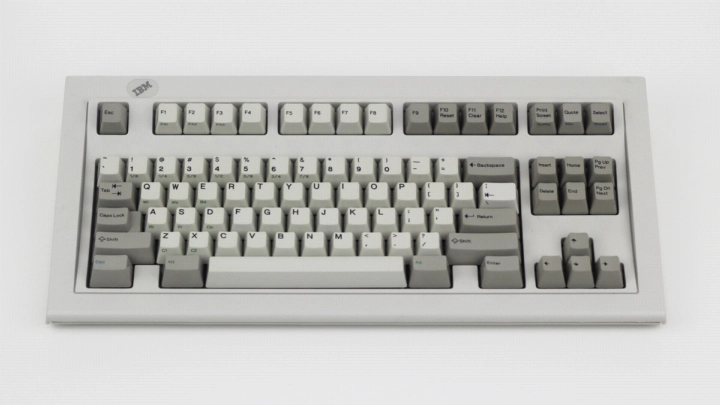
The financial services SSK is another PS/2-based variant seemingly geared towards stockbrokers or financial services professionals. Interestingly, these lack a numeric keypad layer. The keyboard also sports a blue-legend Ctrl key, a dedicated Enter key in place of the right Ctrl (the typical Enter key is marked as a dedicated Return key instead), "Prev" and "Next" legends on the page up and page down keys respectively, "Quote" and "Select" keys in place of Scroll Lock and Pause respectively, IBM 3270-esque "PAx" keys on F1 through F3, "Reset", "Clear" and "Help" legends on F10 through F12 respectively, a back-tab legend on the pipe/forward slash key, and various green sublegends across the alphanumeric keys. 1395217 is the sole known part number and historical details and documentation are scarce.
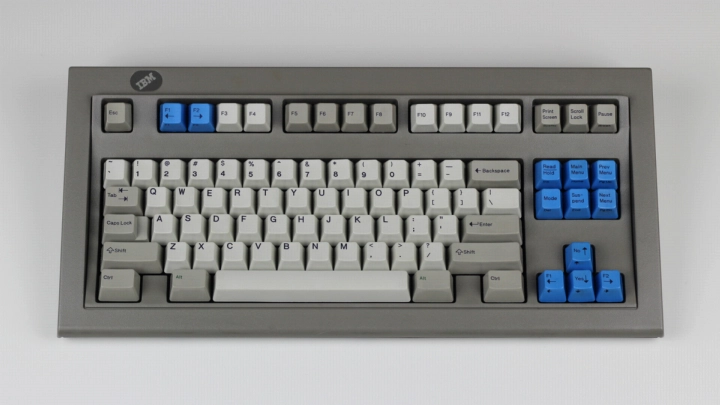
eg, P/Ns 1395691, 1395682, 41G3200
The Industrial SSKs are a cosmetic variation of the standard PS/2, characteristically sporting grey-coloured cover sets designed to hide the dirt and damage expected to be inflicted upon the device within an industrial environment. Industrial SSKs were heavily associated with the automotive industry, with P/N 1395682 and P/N 41G3200 specifically known to be used with Mopar and Ford-owned systems respectively. The "Mopar" version is also iconic for its blue-coloured keys on F1, F2, the navigation cluster and arrow keys.
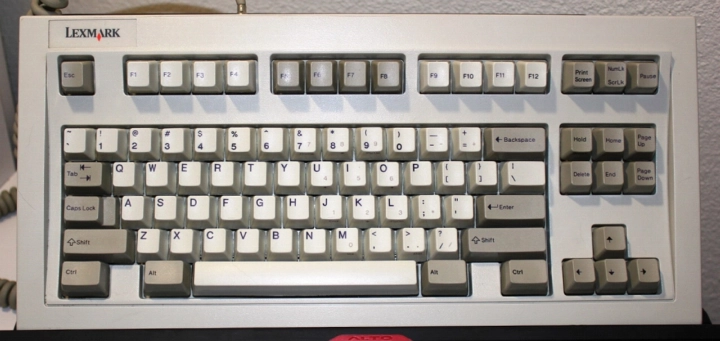
The Lexmark Spacesaver Keyboard is Lexmark's own-branded counterpart to the IBM PS/2 SSK. Besides having the unique rectangular Lexmark branding, it's otherwise an ordinary SSK.

These were the very final SSKs released although they are not newly manufactured keyboards. Most P/N UNI04C6s will say "Modification of IBM P/N 1394054" on their birth certificates to highlight the fact they're made from modified older stock and/or using leftover parts from the IBM and Lexmark era. They are PS/2 SSKs notable for having a US English ISO layout with overlay numeric keypad legends that are a lighter shade of blue than IBM or Lexmark-era SSKs. Unicomp stopped selling these when stock dried up.
Part number list
34 keyboard part numbers have been found in the ASK Keyboard Part Number Database. If you believe a relevant part number is missing, you can help improve this list by requesting a submission for it to be added.
- P/N 1370475: IBM Space Saving Keyboard
- P/N 1390359: IBM Space Saving Keyboard
- P/N 1391472: IBM Space Saving Keyboard
- P/N 1391518: IBM 3162 ASCII Display Station Short Keyboard
- P/N 1392464: IBM Personal Typing System Space Saving Keyboard
- P/N 1392934 (FRU 1393290): IBM Space Saving Keyboard
- P/N 1392980: IBM 3151 ASCII Display Station Space Saving Keyboard
- P/N 1393278: IBM Space Saving Keyboard
- P/N 1393691: IBM Airline Reservation System Space Saving Keyboard
- P/N 1395217 (FRU 1395253): IBM Financial Services Keyboard
- P/N 1395682: IBM 7785 Service Bay System Keyboard
- P/N 1395691: IBM 7785 Service Bay System Keyboard
- P/N 1396046: IBM Space Saving Keyboard
- P/N 1396047: IBM Space Saving Keyboard
- P/N 1397681 (FRU 1397685): IBM Space Saving Keyboard
- P/N 1397961: Lexmark Spacesaver Keyboard
- P/N 41G3200 (FRU 41G3548): IBM 7785 Service Bay System Keyboard
- P/N 41G3565: IBM Industrial Space Saving Keyboard (2767)
- P/N 41G3566: IBM Industrial Space Saving Keyboard (6889)
- P/N 41G3567: IBM Industrial Space Saving Keyboard (2768)
- P/N 41G3568: IBM Industrial Space Saving Keyboard (6891)
- P/N 41G3569: IBM Industrial Space Saving Keyboard (6892)
- P/N 41G3570: IBM Industrial Space Saving Keyboard (2769)
- P/N 41G3571: IBM Industrial Space Saving Keyboard (6894)
- P/N 41G3572: IBM Industrial Space Saving Keyboard (6896)
- P/N 41G3573: IBM Industrial Space Saving Keyboard (6897)
- P/N 41G3574: IBM Industrial Space Saving Keyboard (6898)
- P/N 41G3575: IBM Industrial Space Saving Keyboard (2772)
- P/N 41G3600: IBM Industrial Space Saving Keyboard
- P/N 41G3601: IBM Industrial Space Saving Keyboard
- P/N 41G3602: IBM Industrial Space Saving Keyboard
- P/N 41G3604: IBM Industrial Space Saving Keyboard
- P/N 60G0869: IBM EduQuest Space Saving Keyboard
- P/N UNI04C6: Unicomp 85 Key Space Saver
Indirect successors
Technically speaking, the two successive successors to the Space Saving Keyboard in IBM's eyes had been introduced whilst the SSK proper was still in production. In 1992, IBM and Lexmark developed the Models M4 (non-TrackPoint) and M4-1 (TrackPoint) Space Saver buckling rubber sleeve keyboards for the IBM Personal System/2 E and various ThinkPads (intended for their docking solutions), made available as an option for various IBM systems via the Select-A-Keyboard scheme. Model M4s were referred to as 84/85 key "IBM Quiet Touch Keyboards" as well. The Model M4s are best described as indirect successors since they were IBM's primary tenkeyless keyboards for most of the 1990s, but they did not outright replace the SSK on all fronts. The Space Saver Keyboard was then followed by the NMB-made IBM Space Saver II (model RT3200) introduced in 1999. The name of the RT3200 clearly defines it as the successor of the Model M4s, but Space Saver IIs found themselves with relatively less adoption beyond server console usage. The RT3200 also abandons any Model M family technology, instead using rubber dome key-switches.
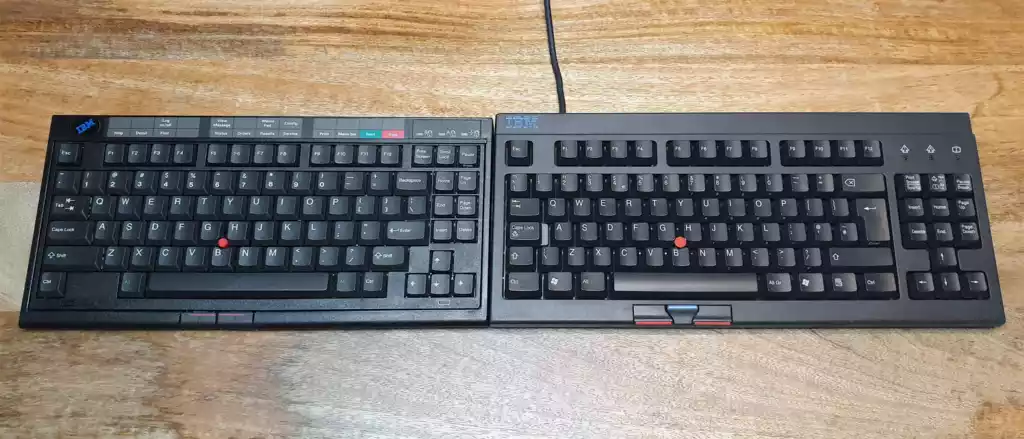
Spiritual successor
Ever since the discontinuation of the SSK, Unicomp had continuously faced calls to reproduce or redevelop a tenkeyless Model M. For almost the entire 2010s, it was known Unicomp was low-key developing such a keyboard but details on progress were scarce. Prior to 2019, the only glimpse of such a new Unicomp keyboard was their 1st April 2014 concept illustration that portrayed a radical departure from a typical Model M design[31]. However, the first photo of a real Unicomp SSK successor appeared on 16th September 2019 that showed a generally more classic design featuring the typical SSK shape and layout but with added GUI keys[32]. On 20th December 2019, it was officially announced as the Unicomp Tenkeyless and slated for an end of 2020 Q1 availability[33]. However, due to the effects of the subsequent COVID-19 pandemic, the launch was pushed back several times. The keyboard finally went on sale on 24th February 2021 and started shipping on 20th March 2021, now called the Unicomp Mini Model M[34]. In addition to the inclusion of GUI keys, the keyboard also sports LED lock-lights, a detachable double-ended USB Type-A cable, and an upgraded membrane and matrix design.
- IBM - IBM 8525, Personal System/2 Model 25 Brief Description of Announcement, Charges, and Availability [accessed 2022-02-27].
- IBM - IBM 3162 ASCII Display Station, new non-IBM emulation cartridges, new 3163/3164 ALA models, IBM 3161, 3163, and 3164 functional enhancement cartridges Brief Description of Announcement, Charges, and Availability (#186-167) [accessed 2022-06-14].
- IBM - IBM 3151 ASCII Display Station Brief Description of Announcement, Charges, and Availability (#187-132) [accessed 2023-01-23].
- IBM - IBM Personal System/2 Model 40 SX (8540-040, 043, 045) Brief Description of Announcement, Charges, and Availability [accessed 2022-02-27].
- IBM - IBM Personal System/2 Model 35 LS (8535-14X) Brief Description of Announcement, Charges, and Availability [accessed 2022-02-27].
- IBM - IBM PS/2 Model 57 SLC Brief Description of Announcement, Charges, and Availability [accessed 2022-03-04].
- IBM - IBM Personal System/2 Model 95 XP 486 (9595-0LF, 0MF and 0MT) Brief Description of Announcement, Charges, and Availability [accessed 2022-02-27].
- Wikipedia - List of IBM PS/2 models [accessed 2022-03-16].
- Ardent Tool - IBM 7785 Hardware Maintenance Reference/Service [accessed 2022-03-27].
- IBM - IBM Industrial Computer Feature Enhancements and Additions Announcement Letter [accessed 2022-03-04].
- IBM - IBM Personal Systems Technical Solutions Issue 4, 1991 (#G325-5013-00) [accessed 2023-10-10]. License/note: document archived by Ardent Tool.
- PC Mag - 25 Feb 1992 [accessed 2022-01-22].
- IBM - IBM PC 300 Series Pentium Systems Announcement Letter [accessed 2022-01-21].
- IBM - IBM PC 700 Series -- Pentium/ISA Systems Announcement Letter [accessed 2022-01-21].
- Tsuyoshi Ide @ ide-research.net - UNI04C6 [accessed 2022-03-26]. License/note: permission requested and explicitly given via direct correspondence.
- Shaddim - File:Bucklingspring-animation-300ms.gif [accessed 2021-09-09]. License/note: CC-BY-2.0.
- IBM - Rocking switch actuator for a low force membrane contact switch [accessed 2021-06-17].
- Unicomp - The Customizer Keyboard [accessed 2022-10-04]. License/note: retrieved via Wayback Machine (2000-06-14 capture).
- Blake Patterson - File:Blake Patterson IBM Model M Keyboard space saver open back.jpg [accessed 2021-09-09]. License/note: CC-BY-2.0 (cropped & perspective corrected).
- troyfletcher#5223 - Discord Message #252446027745853442 on IBM keyboards | /r/ModelM & F [accessed 2023-02-21].
- WASD Keyboards - Mechanical Keyboard Guide [accessed 2022-07-01].
- Switch And Click - ABS vs PBT Keycaps: What’s the Difference? [accessed 2021-09-09].
- Joe/Ellipse @ modelfkeyboards.com - Converted RJ-45 Terminal IBM Model M SSK 1392980 [accessed 2022-03-16]. License/note: permission requested and explicitly given via direct correspondence.
- ClickyKeyboards.com - IBM model M 84-key (space saving SSK) 1392980 10-09-91 [accessed 2022-04-04].
- P. Zwettler - IBM Model M SSK 1392464 DisplayWrite [accessed 2022-02-27]. License/note: All Rites Reversed.
- Wikipedia - List of IBM PS/2 models [accessed 2024-05-17].
- JP! @ deskthority - IBM 6901 "Personal Typing System" [accessed 2024-05-17].
- P. Zwettler - IBM Model M SSK 1395217 [accessed 2022-02-27]. License/note: All Rites Reversed.
- P. Zwettler - IBM Model M industrial SSK 1395682 [accessed 2022-02-27]. License/note: All Rites Reversed.
- elecplus - A Comparison of SSKs [accessed 2022-04-10]. License/note: permission requested and explicitly given via direct correspondence.
- Unicomp - 2014-04-01 Facebook Post [accessed 2023-02-20].
- Unicomp - 2019-09-19 Facebook Post [accessed 2023-02-20].
- Unicomp - 2019-12-20 Facebook Post [accessed 2023-02-20].
- Unicomp - 2021-02-24 Facebook Post [accessed 2023-02-20].
| Published | Comment |
|---|---|
| 17th May 2024 | Replaced various used enthusiast terminology with official terminology & updated Personal Typing System subsection |
| 18th November 2023 | Moved introduction ahead of Contents & updated Unicomp New Model M link |
| 19th April 2023 | Add part number list section |
| 10th April 2023 | Rename "Variations" section to "Known variants" |
| 12th March 2023 | Mention side profile relation with M50, SRK, New M and Mini M |
